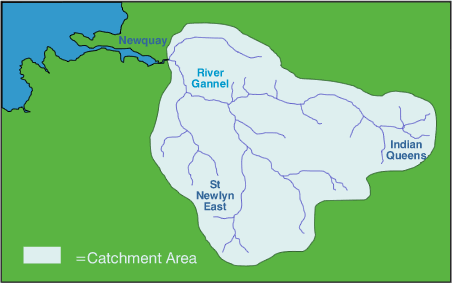River Catchments
– GANNEL
The river Gannel rises on Newlyn Downs and drains a 60 km2 area, running approximately 11km and into the sea over Crantock Beach, to the West of Newquay Town. The catchment is underlain by Devonian calcareous slates, grits and limestone which are unsuitable for the formation of a major aquifer. Owing to low permeability, rainfall results in rapid run-off and therefore stream levels rise quickly after rain.
The estuary is a proposed Special Area of Conservation (SAC), while Newlyn Downs are a designated Site of Special Scientific Interest and candidate Special Area of Conservation under the EC Habitats Directive. Many water dependent plant species are supported here together with South Atlantic wet heath, Bog Pimpernel Anagallis tenella, Bog Myrtle Myrica gale, Bog Asphodel Narthecium ossifragum, Common Fleabane Pulicaria dysenterica, Lousewort Pedicularis sylvatica and common Cotton grass Eriophorum angustifolium, also rare Dorset Heath.
Key habitats and species of the Gannel estuary are its wading birds (little egret), plants (eel grass beds and associated species), fish (salmon, bass, smelt and shad) and there are also significant populations of both brown and sea trout. Throughout the freshwater section, trout, lamprey, eel, and bullhead have been recorded. The Gwills river gauging station is noted as an obstruction to fish movement at lower flow levels.
Rainfall is typically 1500mm per annum and owing to the area’s mild climate, there is a predominance of agriculture focusing on the production of early potatoes, brassicas and daffodils, along with mixed dairy units.
The main environmental threats come from pollution (notably from the now closed Wheal Rose Landfill), recreation and development of this popular tourist area. Crantock Beach in Newquay has experienced bathing water failures in the past.
The majority of farms in the Gannel are small to medium, mixed enterprises with beef, sheep and small areas of arable, there are also a number of dairy farms and a few larger specialist arable farms.
During the project 34 farms were visited within the Gannel catchment covering an area of some 2,425 hectares (40% of the catchment). Six and a half kilometres of fencing have also been erected in the catchment which will help minimise livestock access and reduce soil loss and erosion.
Owing to water quality issues at the beaches, advice was focussed on best practice in nutrient management; specifically looking at fertiliser inputs and management of livestock manures. The advantages of the new Environmental Stewardship schemes were promoted and farmers signposted to sources of ongoing further advice.
